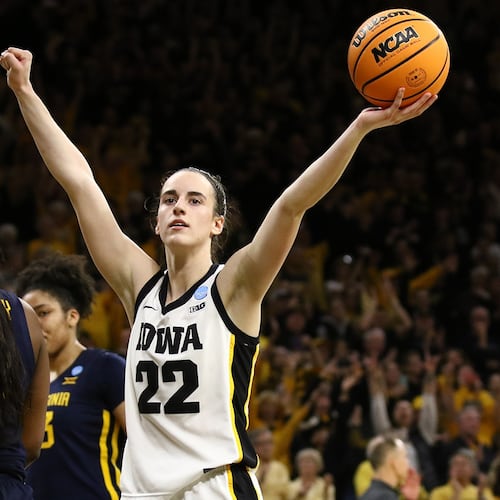If you’re among those who stopped watching October baseball because the Braves weren’t playing – this is their first postseason trip since 2013 – or stopped sticking around – they haven’t won a series since 2001 – the first real playoff game of 2018 should prepare you for what’s ahead. The National League wild card tilt lasted four hours and 55 minutes. It ended after 1 a.m. Eastern time.
It saw three runs scored – one in the top of the first, one in the bottom of the eighth and one in the top of the 13th. It was a game both gripping and grating, and it was illustrative of what baseball has become. Since nobody hit a home run, nobody did much scoring. Game 2 of last year’s World Series showed how this sport has, in the era of Three True Outcomes (strikeout/walk/ homer), become a prisoner of the bloodlust to hit a ball over the wall.
That game featured eight home runs, five of them in extra innings. (Charlie Culberson, then a Dodger and now a Brave, hoisted the long night’s final homer.) Thirteen runs were scored; only one didn’t come via the long ball, and it was the result of a sacrifice fly. As much as managers advise their men to Keep The Line Moving and Put The Ball In Play, the sport has been reduced to wallop-or-whiff.
The Rockies and Cubs combined for 17 hits Tuesday night/Wednesday morning. They also combined for 29 strikeouts. The winning pitcher was Scott Oberg, who’s not even the Colorado closer. (He has two career saves.) He faced four Cubs. He struck out all four.
This shouldn't have surprised anyone. The regular season just completed was the first in baseball annals to see more strikeouts (41,177) than hits (40,993). As Joe Sheehan wrote: "There is no possible way that strikeouts being as common as -- or more common than -- hits is consistent with the design of the game. There's no possible way strikeouts being as common as hits maximizes entertainment."
Having watched most but not quite all – four hours and 55 minutes is a long time – of Tuesday’s game, I can’t say that much of it wasn’t riveting. (Unlike Monday’s strange tiebreakers, this was an elimination game.) But baseball has become so skewed by power pitching that I’m not sure it qualified as entertaining. The Cubs have been baseball’s best team over the past four seasons, averaging 97 wins per annum. They played 22 innings the past two days. They scored two runs. One came on Anthony Rizzo’s homer against the Brewers.
The Cubs deployed nine pitchers over 13 innings Tuesday, eight over the final seven. Jon Lester, who finished second in the National League Cy Young voting in 2016, started. Cole Hamels, MVP of the 2008 World Series, relieved in the 10th. Kyle Hendricks, third in the 2016 Cy Young balloting, came on in the 12th. Maybe it was coincidental that Colorado’s winning rally came against one of the few good pitchers who doesn’t throw 95 mph. Probably not.
With strikeouts coming hand over fist, just Putting The Ball In Play becomes an achievement. The thought of three batters mustering consecutive singles seems a distant memory of another era. (The Pleistocene, maybe.) That, miracle of miracles, is what happened in the 13th. With two out, Trevor Story singled to left. Gerardo Parra singled to right. Up stepped Tony Wolters, a backup catcher who’d hit .170 over the regular season with – yes, indeed – more strikeouts than hits.
There used to be a piece of baseball advice: Never throw a change-up to a bad hitter – because a bad hitter can’t handle a fastball and is praying for anything off-speed. Wolters said afterward that he was hoping for a change-up, which is Hendricks’ stock in trade. Wolters got it and drove it up the middle. It was his first hit since Sept. 10. The Rockies, who’d been forced to play three games over three days in three different time zones, had the lead they’d keep.
(Someone asked Wolters the awful question: Was this the biggest hit you've ever had? He offered the only possible response: "Are you kidding me?")
That part was neat – unlikely difference-maker, improbable ending, underdog prevailing. Still, four hours and 55 minutes! Game 6 of the 1975 World Series, which went 12 innings and ended with Carlton Fisk’s home run off the Fenway foul pole, saw 13 runs scored 24 hits against 14 strikeouts. It took 4:01.
I know, I know. Times have changed. But if you’re about to restart watching the MLB playoffs because the Braves are involved, you mightn’t recognize what you see. When last the local club won a playoff series, there were no iPhones or iPads. Heck, the first iPod – remember those? – would be introduced later that month. We didn’t have nearly as many entertainment options in 2001, and baseball was, dare we say, far more entertaining than it is today.
Even if you like the sport – I do – it can be a slog. Even if the team you’re following is fun to watch –the Braves are – they’re still playing baseball in 2018, which is to say they’re playing a game out of plumb. Everybody’s trying to hit a homer but, because there aren’t any bad pitchers working in October, a chunk of pressurized innings can pass with nothing happening except guys swinging and missing.
Maybe that means the pitchers are just good. Maybe it means they’re too good. Maybe the Braves will profit from this. (They have good pitchers, too.) And there’s nothing wrong with low-scoring games per se. Game 7 of the 1991 World Series – Jack Morris against John Smoltz – finished 1-0 in 10 innings. But there were 17 hits that night against 13 strikeouts, and you know how long it lasted? Three hours, 23 minutes.
About the Author
The Latest
Featured


